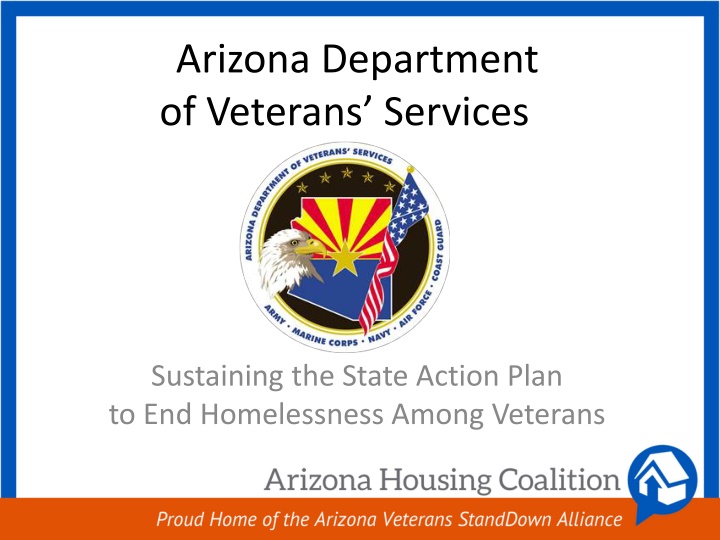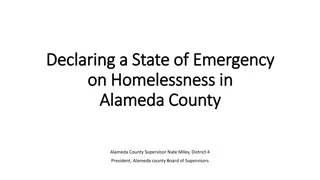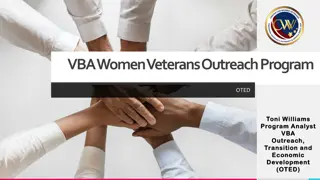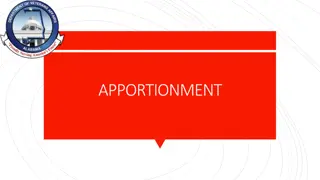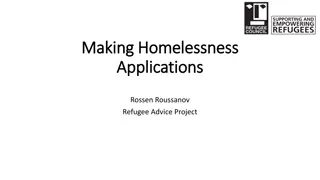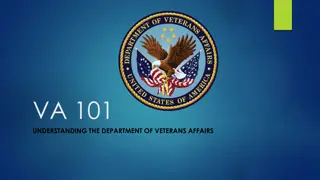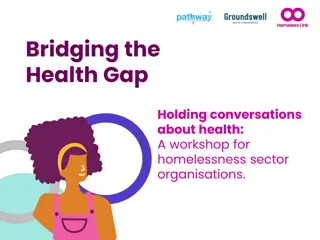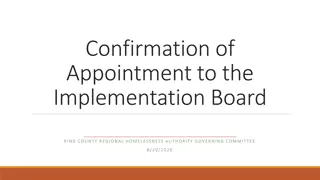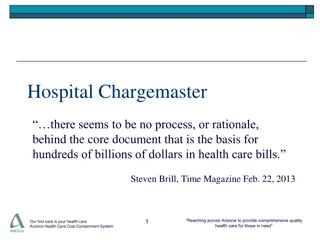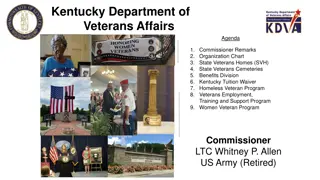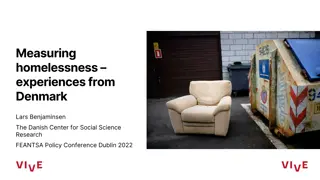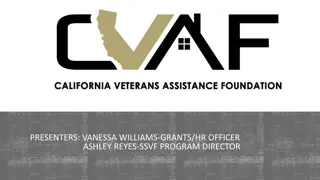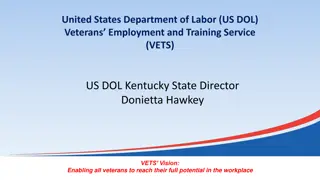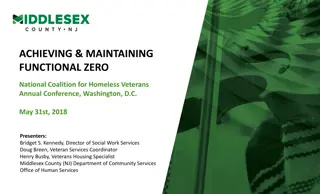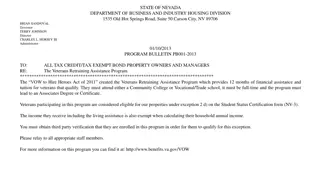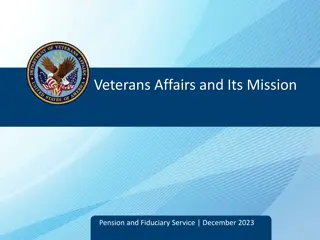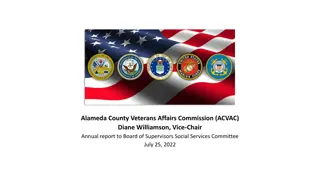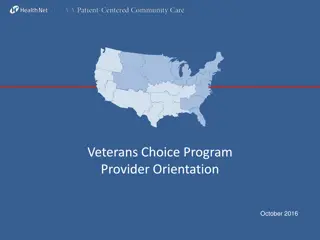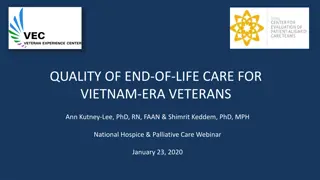Arizona Department of Veterans Services Action Plan to End Homelessness Among Veterans
Arizona Department of Veterans Services launched a comprehensive action plan in 2011 to eradicate chronic homelessness among veterans. The plan involved various initiatives such as Project H3 Vets, adding housing units, and establishing support programs. Despite challenges in sustainability, efforts continued with the creation of the Arizona Stand Down Alliance and the Arizona Military/Veteran Resource Network. The plan was updated in 2017 to address current obstacles and maintain collaborative efforts for long-term success in housing veterans effectively throughout the state.
Download Presentation

Please find below an Image/Link to download the presentation.
The content on the website is provided AS IS for your information and personal use only. It may not be sold, licensed, or shared on other websites without obtaining consent from the author.If you encounter any issues during the download, it is possible that the publisher has removed the file from their server.
You are allowed to download the files provided on this website for personal or commercial use, subject to the condition that they are used lawfully. All files are the property of their respective owners.
The content on the website is provided AS IS for your information and personal use only. It may not be sold, licensed, or shared on other websites without obtaining consent from the author.
E N D
Presentation Transcript
Arizona Department of Veterans Services Sustaining the State Action Plan to End Homelessness Among Veterans
Arizona Action Plan to End Homelessness Among Veterans In 2011 ADVS implemented the plan outlining goals, strategies and objectives to guide the community in its mission of ending chronic homelessness among veterans over a 5 year span 222 chronically homeless veterans were identified in the initial assessment of the community. Arizona Coalition to End Homelessness (AZCEH) led an effort known as Project H3 Vets and housed 325 Veterans, reducing the scope to 18 Veterans in a two year period. New Per Diem beds were added, as well as 6 Statewide SSVF programs 772 housing units with Veterans preference through AZ Dept. of Housing Low Income Housing Tax Credit Program
Action Plan continued Arizona Stand Down Alliance created, supporting the coordination of 10 annual Stand Downs serving 12 counties. Arizona Coalition for Military Families further enhanced capacity for statewide coordination with the development of the Arizona Military/ Veteran Resource Network. However
Collaborative Spirit Difficult to sustain Coordination and data management difficult to maintain/ sustain There was a need to conduct summits throughout the State to determine what obstacles communities were facing, to update the State Plan to End Homelessness Among Veterans. Changes to the plan reflect the feedback of communities Statewide. The Arizona Action Plan to End Homelessness Among Veterans: Sustaining the Future 2017 was created.
Regionalized Objectives Under each goal, there are objectives for each region throughout the State. We will continue to push until all veterans experiencing housing instability can be housed rapidly in a home they can afford and an area they want to live The Arizona Action Plan to End Homelessness Among Veterans can be located on our website at www.dvs.az.gov under the resources Tab.
Regionalized Objectives Goal 1 Ending Street/ Shelter Homelessness Among Veterans Strategy: Increased the coordination of resources for Veterans living on the streets or in emergency shelters through the development of Critical Response Units (CRU s) Goal 2 Transform the Temporary Help System Strategy: Coordinate a plan for GPD programs to adopt new models of care with the capacity of ending street and shelter homelessness Goal 3: Ensure Ongoing System Functionality for all Veterans Experiencing Homelessness Strategy: Ensure statewide systems for veterans experiencing housing instability include prevention with a balance of affordable housing and supported housing
Arizona Dept. Veterans Services: Veteran Tool Kit Program
What is the Veteran Tool Kit program? Many Veterans throughout the State have remarked that if they only had the supplies or tools necessary to work in their trade, they could begin work immediately. AZDVS and the Arizona Department of Economic Security wanted to determine if these comments were anecdotal or if there was validity to the concern. During the month of May 2017, Disabled Veteran Outreach Program Specialists (DVOPS) employees polled Veteran clients. Their question, If you were provided with tools necessary for you to work in your trade, would you become gainfully employed.
Poll results Veterans Polled 107, 38% Yes, I Would Be Employed No, I Would Not 176, 62%
Poll Results More than half (62%) of those polled believe they would be able to begin work immediately if provided the necessary tools to work in their trade. The Veteran Tool Kit program was created to reduce the number of unemployed Veterans; specifically, those Veteran employment seekers that would obtain gainful employment if provided the necessary tools for their trade. This pilot project will expend $150,000.00 over the course of FY 2018, with a limit of $750.00 per Veteran. Results will be analyzed in FY 2019 for efficacy.
Veteran Tool Kit Application
Application continued The application is a simple, form fillable document, requiring only minutes to complete. The Veteran is responsible for providing the list of tools they need. Since the contractor will be using Amazon to purchase the items, it is strongly recommended that the Veteran find the tools they need on the Amazon.com website, and provide the necessary information to ensure an accurate order such as: color, size, sku #, quantity and any other special instructions. Leave the internal use area blank, that will be filled out by the contractor All referrals will be taken by DES staff, who will scan the application and supporting documentation. Orders will be placed upon receipt and delivered within 48 business hours to the residence of the Applicant.
Who Qualifies? 1.) Veterans residing in Arizona 2.) Veterans enrolled in a DES workforce program 3.) Veterans that self report they are able to obtain employment if provided the Veteran Tool Kit Intervention.
Role of the Dvop/ Lver In working with a Veteran seeking gainful employment, your judgement should be used in considering whether the Took Kit intervention will be successfully applied with the Veteran you are working with. Things to consider would be work history, and the prior trades the veteran has worked in. Also, will the intervention yield gainful employment, or just quick on the side jobs Is the Veteran requesting reasonable items for obtaining employment?
Examples Good Referral: Bob has been working with a veteran (Jim) in the construction trades that was recently laid off. Jim has been struggling to pay his bills on unemployment, and has had difficulty finding new employment because he had to pawn his toolbox and tools therein to pay his car note. Jim has found a company in Phoenix willing to hire him due to his construction experience, but Jim must have the following: hard hat, steel toe boots, reflective vest and basic tools such as a hammer, wrenches and a drill. Jim goes on Amazon and finds all the tools he needs to start his job, and it s under $750.00. Jim fills out the application with his DVOP, attaches the Amazon list to the application and the DVOP sends the email with scanned documents. Jim receives his tools 3 days later at his doorstep and begins work.
Examples Bad Referral: Bob is working with a Veteran that has had several different jobs over the last 10 years in various trades. Most currently this veteran worked part time as a bus boy, but has also waited tables, valeted cars, and prior to this worked in IT, but due to a criminal offense was fired from his job because it was a major security threat and is still on probation. The Veteran is requesting to resale $750.00 worth of amazon merchandise to make some quick money to help pay his rent. This would not be considered gainful employment and unethical use of money, therefore not an approvable request.
Shane Groen Special Initiatives Director for the Arizona Housing Coalition
The Arizona Coalition to End Homelessness merged with the Arizona Housing Alliance in 2017. The majority of each agency s programming remains in place, including our annual statewide homeless conference and the Arizona Veteran s Stand Down Alliance AZHC partners with AZDVS to fund statewide StandDown events Member meetings to improve coordination and build consensus on key housing and support services issues. Continue to provide evidence-based, best practice trainings and workshops on in ending homelessness and building support for affordable housing development and healthy communities.
What is a Stand Down? Stand Down is a military term for respite from battle Annual events for homeless and at-risk veterans Ten events serving nearly every county in Arizona The goal is bringing service providers together in one place to connect our veterans with those services
Service Providers Dental Courts/legal MVD DES Social Security Ultrasound Women s only area Veterinary Services Housing Services Haircuts Hygiene kits Behavioral Health Acupuncture VA VBA Meals Medical Services Eye Glasses Community Providers Employment Opportunities Suicide Prevention Resources Substance Abuse Resources Emergency Shelter Education Assistance Phone/Voicemail Domestic Violence Resources Financial Planning
Ending Veteran Homelessness in Maricopa County
The Framework 3. Accurate Data and Current Structure 4. Create milestones and try Change Ideas 1. Get the right people at the table 5. Establish policies for consistency 2. Agree on a Clear Vision
Atmosphere Focused on our vision Safe place to communicate Vulnerability and Honesty Educating those on the team that are new or don t understand Find successes to inspire
The Right People GOVERNMENT PROVIDERS COMMUNITY Phoenix VA City of Phoenix City of Mesa Maricopa Association of Governments Continuum of Care Community Bridges Inc. Human Services Campus U.S. Vets Crisis Response Network CASS Vets MANA House UMOM Save the Family Community Solutions Cloud Break Communities Arizona Housing Coalition
Team Maricopa County Phoenix VA Maricopa Association of Governments Community Bridges Inc. City of Mesa City of Phoenix Crisis Response Network U.S. Vets Human Services Campus UMOM Community Solutions CASS Vets MANA House Safe the Family James Walton House Ozanam Manor Arizona Department of Veteran Affairs Cloud Break Communities
Clear Vision End Veteran Homelessness in Maricopa County, starting with Chronically Homeless Veterans.
Accurate Data (April 2018) Outflow Inflow Active 465 182 177 New:102 Housed (placements and positive exits): 110 Returned from Housing: 12 Moved to Inactive: 67 Returned from Inactive: 75
Mapping Our Current Process
Successes 1. Workgroup developed policies and procedures to ensure consistency 2. Case Conferencing was established 3. Quality Data 4. Increased resources and Housing Placements 5. VA signed a Partnership and Data Sharing Agreement 6. VA started entering data into HMIS
Contact us: John Scott Deputy Director for the AZ Department of Veterans Services Office: 602-234-8415 joscott@azdvs.gov Shane Groen Special Initiatives Director for the AZ Housing Coalition Office: 602-340-9393 shane@azhousingcoalition.org
